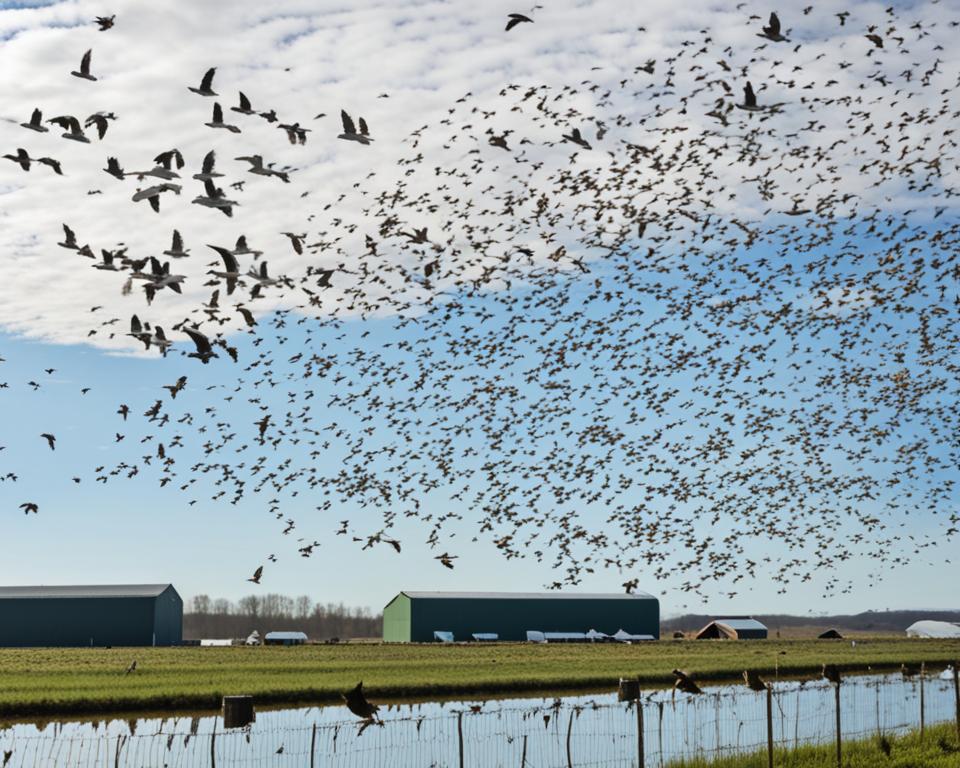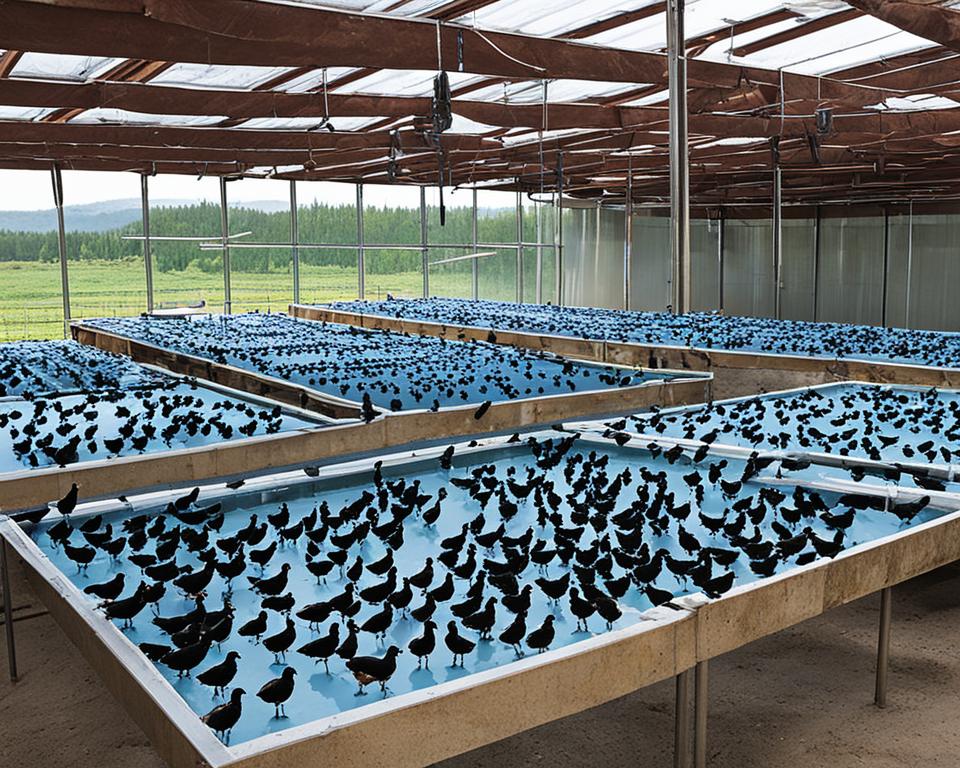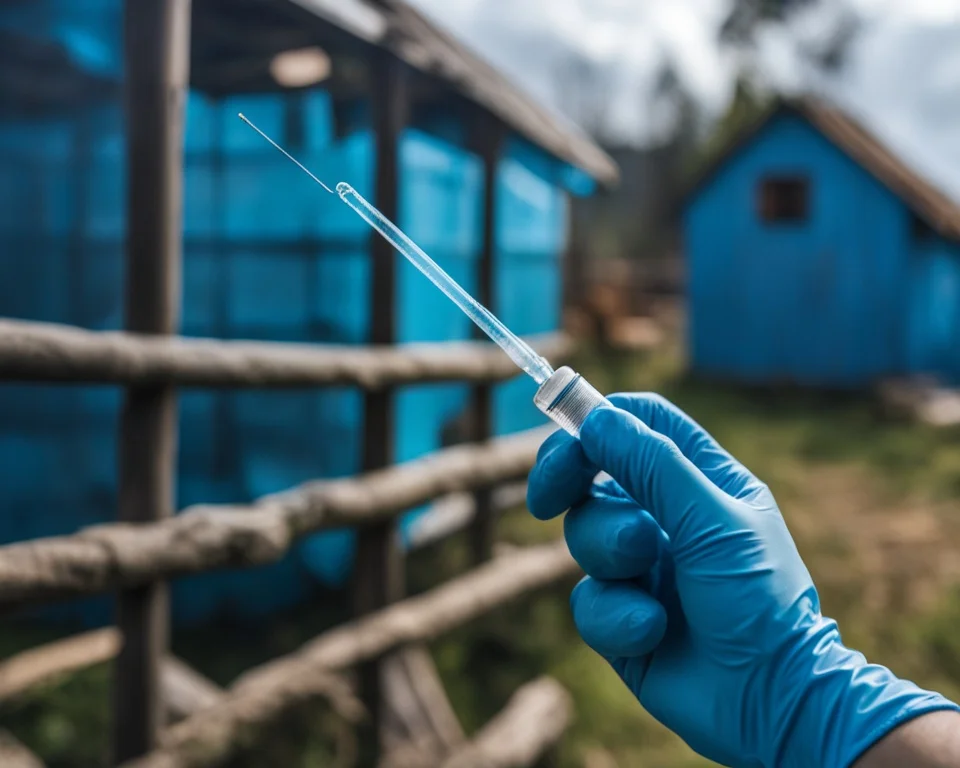
Are you ready to protect your poultry from H5N2 avian influenza? This virus is highly pathogenic and could devastate the agricultural sector. In the US alone, about 97 million birds were hit by the virus.
The 2022 outbreak has already affected more than 1,000 flocks in 48 states, infecting over 200 mammals.1 So, it’s crucial to know the top 5 strategies to tackle this new threat.
Table of Contents
ToggleKey Takeaways
- H5N2 avian influenza is a highly pathogenic virus that can rapidly spread among bird populations, leading to devastating outbreaks.
- Implementing robust biosecurity measures, including restricting access and proper disposal of dead birds, is crucial to prevent the virus from entering poultry farms.
- Rigorous monitoring and surveillance programs are essential for early detection and swift response to suspected cases of H5N2 avian influenza.
- Culling infected flocks and establishing quarantine zones are key components of a rapid response and containment strategy.
- International cooperation and information sharing among government agencies, public health organizations, and agricultural authorities are vital in the global fight against H5N2 avian influenza.
Understanding H5N2 Avian Influenza
H5N2 avian influenza is a serious type of bird flu. It mostly affects birds like chickens and wild ducks. This virus is named H5N2 because of its special surface parts, H and N.2
What is H5N2 Avian Influenza?
The H5N2 bird flu is part of the larger influenza A family. Other types include H1N5, H5N1, and H4N2. These viruses can move between bird and mammal species, even to people.3
History and Origins
The first human case of H5N2 bird flu was confirmed on May 23, 2024. This was in Mexico. A study from 2022 showed this virus had already been spread to different countries by then.2
Transmission and Spread
In March 2024, a farm in Michoacán, Mexico, had an outbreak of the bad H5N2 bird flu. This was close to where the first person caught it. Other, less harmful, strains were found nearby later on.2
A 59-year-old person in Mexico died from the H5N2 bird flu. They had some other health problems too. After this, 17 people who might have been in contact were checked. Only one of them had a mild cold, and they didn’t have the bird flu.2
The World Health Organization (WHO) says the risk of this bird flu spreading to lots of people is low. They remind us to keep an eye on flu viruses because they can change quickly. This helps protect both people and animals.2
Biosecurity Measures for Poultry Farms
It’s essential to have strong biosecurity measures to fight against h5n2 avian influenza.4 Poultry farms need to limit who comes in, to prevent the virus from getting in.4 Everyone who goes in or out must go through a thorough cleaning process,4 wear special clothing, and dispose of any waste properly.
Restricting Access to Farms
For better biosecurity measures on poultry farms, it’s vital to control who gets in.4 A study found 44 ways biosecurity could be breached in poultry houses,4 showing the need for tight controls on access.4Only necessary people should be allowed in, and a detailed list of who’s been there should be kept.
Proper Disposal of Dead Birds
If there’s an outbreak of h5n2 avian influenza, safely getting rid of dead birds is key.5 Poultry farms must have a well-thought-out plan for this.5 They need to dispose of the birds correctly, which might mean burning them, using special methods to break them down, or composting in a specific way to stop the disease from spreading.
Disinfection and Sanitation Protocols
Keeping up with disinfection and sanitation is crucial for poultry farms facing h5n2 avian influenza.4 Tools like “Biocheck.UGent” help measure how good our cleaning methods are with the risk of h5n2 spreading.4 Everyone coming in needs to be very clean, use the right safety gear, and handle dirty stuff safely.

h5n2 avian influenza
The H5N2 avian influenza virus is part of the influenza A family. It has subtypes like H1N5 and H5N1. These viruses can move between bird and mammal species, including us humans.2
The first human case of H5N2 was confirmed on May 23, 2024.2 In March 2024, a deadly H5N2 outbreak was found in Mexico. This was followed by a less harmful outbreak in the same area in April.2
H5 viruses have been in Mexican birds since the 1990s.6 Though H5N1 can be deadly to humans, the H5N2 case in Mexico only caused mild illness.6
The World Health Organization said the risk of H5N2 to most people is low.2 Since the first case, no others have been reported.2 WHO stresses the need to watch for changes in these viruses that could affect us or animals.2
| Statistics | Value |
|---|---|
| First confirmed human case of H5N2 bird flu | 59-year-old man in Mexico who died in April6 |
| Contacts of infected individual tested | Twelve additional contacts near the infected individual’s residence were identified; all tested negative for SARS-CoV-2, influenza A, and influenza B by RT-PCR.2 |
| Neuraminidase inhibitors effectiveness | Neuraminidase inhibitors (oseltamivir, zanamivir) are noted to improve survival prospects in some cases of avian influenza virus infections in humans.2 |
| Existing vaccines for influenza A(H5) | No specific vaccines exist for preventing influenza A(H5) virus infection in humans, though candidate vaccines have been developed for pandemic preparedness purposes.2 |
Monitoring and Surveillance Strategies
It’s crucial to have good monitoring and surveillance strategies against h5n2 avian influenza. Poultry farmers and industry stakeholders should have active monitoring programs. They need to check their flocks’ health often.7
This includes testing for H5N2 and watching for sick or odd-acting birds.
Reporting systems for suspected cases of h5n2 avian influenza are vital too.7 Between 2008 and 2013, about 119 countries checked wild birds for avian influenza.7 In the survey, 46 out of 178 OIE member countries shared their surveillance info.7 Also, about 25.8% countries did both active and passive surveillance. Meanwhile, 30.4% were only active, and another 30.4% had passive surveillance.
Having strong monitoring and surveillance is key to catch and deal fast with any h5n2 avian influenza outbreaks.78
Rapid Response and Containment
When an h5n2 avian influenza outbreak hits, quick action is key to keep it from spreading.9 This means a fast response to cull infected poultry flocks. By euthanizing exposed birds right away, the virus’s chance to move to new places is cut down.
Culling Infected Flocks
Culling infected poultry flocks is crucial in the fight against h5n2 avian influenza.9 It involves putting down all birds in contaminated flocks to stop the virus from traveling. Quick culling is a big step in preventing the h5n2 virus from reaching other farms or wild birds.
Establishing Quarantine Zones
Setting up quarantine zones around confirmed outbreak sites is also vital.9 These areas stop poultry, people, and equipment from moving and spreading the virus. Quarantine zones allow for focused disease checks and disinfection to keep the virus from moving on.

Personal Protective Equipment
Using personal protective equipment (PPE) is key for those in the path of the10 H5N2 avian influenza, like farmers and response teams. Gloves, N95 masks, and more can cut the risk of catching the virus.
Proper Use of PPE
If you’re in places with the11 H5N2 avian influenza, you need to know how to use PPE properly. This means making sure it fits right, tossing out the used pieces safely, and reducing the chance of getting sick.12 Experts saw no one get sick from the flu when handling infected birds. This shows PPE can really protect you.
Disposal of Contaminated PPE
Getting rid of used PPE the right way stops the spread of the10 H5N2 avian influenza. Put it in biohazard bins and follow disposal rules. This helps keep the virus from spreading more.11 People dealing with sick birds or their materials face a higher flu risk. So, using and tossing PPE correctly is crucial for everyone’s safety.

Vaccination Programs
Currently, there are no approved vaccines for humans to protect against the H5N2 avian flu virus. But the agricultural sector is working hard to create effective vaccines for birds.13 They are testing vaccines like inactivated virus vaccines and recombinant vaccines. They use engineered protein parts of the virus.
Types of Vaccines Available
The poultry industry is trying different vaccine types against the H5N2 virus. Inactivated virus vaccines are one approach. These vaccines make use of weakened or killed H5N2 viruses. They have shown they can help birds build immunity.14 There are also recombinant vaccines. These include specific viral proteins. They use the latest scientific techniques to help vaccination be more efficient.
Vaccination Strategies
Good vaccination plans are key in the struggle against the H5N2 avian flu.14 The first round of vaccines for birds varies by program. It can start from the time they are inside the eggs to when they are 6 weeks old.
Vaccinating the most at-risk bird types in common transmission spots is the best strategy to weaken outbreaks.14 In case of an emergency, surrounding areas up to 3 km away with protective vaccines is better than just immediate areas or those farther out.
To see if vaccines can stop the spread, scientists use a factor called R. It tells us how many new infections one person with the flu might cause.14 When testing a vaccine, they look at how it makes birds less likely to get sick or die. They also check if it lowers the amount of the flu the birds can spread.
Scientists also look into how well a bird’s blood can fight off the flu after being vaccinated. This is measured by certain antibodies in the blood.14 They are testing different vaccination plans to see how they can slow down the flu’s spread. This includes rapid response, protective measures, and preventative actions in regions where the risk is high.

International Cooperation and Information Sharing
Combatting h5n2 avian influenza is a worldwide fight. We need countries to work together. The World Organisation for Animal Health (OIE) started in 1924 with 28 countries.
Now it has 167 countries as members.15 These countries work together to fight diseases like H5N2. The disease is listed under the OIE’s A1 group, meaning it’s dangerous and can spread quickly.15
The OIE has over 150 Reference Laboratories and 13 Collaboration Centers. They are experts in animal diseases, including avian influenza.15
They also have a network of 300 animal health experts. This helps the OIE take a strong, broad approach to fighting h5n2 avian influenza.15
Sharing information between countries is key. Government organizations, public health groups, and farming experts need to work together. The OIE highlights the big steps everyone needs to focus on.
These include watching for diseases early, being quick to respond, and checking the safety of our food. They also work on how to trade poultry safely to stop diseases from spreading.15
The OIE works closely with the North American Plan for Animal and Pandemic Influenza (NAPAPI). The plan joins efforts between Canada, Mexico and the United States.
They aim to spot and handle outbreaks better. Also, they try to keep everyone informed and reduce the impact of these diseases on society and the economy.16
Additionally, the OIE teams up with the WHO Influenza Reference Laboratories. They help share scientific data and virus samples. This sharing is vital for fighting the h5n2 avian influenza globally.15
Working together globally and sharing data helps fight h5n2 avian influenza. Countries, health groups, and farmers can protect poultry and reduce harm to agriculture. This teamwork is crucial against the virus.
Conclusion
The H5N2 avian influenza virus is a huge threat to poultry farms, agriculture, and public health in the U.S6. Fighting this virus requires a solid, joined-up plan.
To beat this dangerous virus, we need to do several things. Improving farm security and keeping a close watch are a must. So is acting fast to control any spread. Wearing the right gear, helping with vaccines, and sharing info worldwide also matter61718.
Doing these things will help keep our birds safe and protect people. Working together, farmers, health workers, and others must fight this bird flu hard. The fight against the H5N2 avian influenza needs everyone’s help.
FAQ
What is H5N2 avian influenza?
H5N2 avian influenza is a strong strain of the flu A virus that mainly affects birds. This includes farm birds and wild waterfowl. It’s named after the special proteins on its surface.
How can biosecurity measures help combat H5N2 avian influenza?
Good biosecurity is vital in stopping H5N2 avian influenza. This means keeping poultry areas safe. This includes limiting who can enter, disinfecting wells, and safely getting rid of anything that could have the virus.
What monitoring and surveillance strategies are effective for H5N2 avian influenza?
The best way to keep an eye on H5N2 is by watching poultry closely and testing them often. This helps to catch the virus early and stop it from spreading.
How can rapid response and containment help combat H5N2 avian influenza?
Quick action is key when H5N2 shows up. This means culling infected chicken quickly to avoid the virus spreading more. It’s a big step in fighting it off.
Why is the use of personal protective equipment (PPE) important for H5N2 avian influenza?
PPE is a must for farmers and anyone working with birds. Using it decreases the chance of catching and spreading the H5N2 virus.
How can vaccination programs help combat H5N2 avian influenza?
There are no human vaccines for H5N2 yet. But, there are vaccines for birds. These are made to help keep poultry safe from the virus.
Why is international cooperation and information sharing important for combating H5N2 avian influenza?
Tackling H5N2 needs everyone working together, worldwide. Sharing what we know and helping each other is key in stopping this dangerous virus.
Source Links
- https://www.webmd.com/cold-and-flu/what-know-about-bird-flu
- https://www.who.int/emergencies/disease-outbreak-news/item/2024-DON520
- https://www.cdc.gov/flu/avianflu/influenza-a-virus-subtypes.htm
- https://www.ncbi.nlm.nih.gov/pmc/articles/PMC10465163/
- https://www.cdfa.ca.gov/ahfss/Animal_Health/Avian_Influenza.html
- https://www.nbcnews.com/health/health-news/h5n2-bird-flu-know-first-human-case-rcna155821
- https://www.ncbi.nlm.nih.gov/pmc/articles/PMC4378471/
- https://www.aphis.usda.gov/media/document/1296/file
- https://www.publicsafety.gc.ca/cnt/rsrcs/pblctns/nml-pndmc-nflnz/index-en.aspx_
- https://www.cdc.gov/flu/avianflu/avian-in-birds.htm
- https://www.cdc.gov/flu/avianflu/clinicians-evaluating-patients.htm
- https://www.ncbi.nlm.nih.gov/pmc/articles/PMC6478193/
- https://www.ncbi.nlm.nih.gov/pmc/articles/PMC5331804/
- https://www.ncbi.nlm.nih.gov/pmc/articles/PMC10563699/
- https://www.ncbi.nlm.nih.gov/books/NBK22152/
- https://www.publicsafety.gc.ca/cnt/rsrcs/pblctns/nml-pndmc-nflnz/index-en.aspx
- https://www.ncbi.nlm.nih.gov/pmc/articles/PMC1193578/
- https://www.ncbi.nlm.nih.gov/pmc/articles/PMC5666040/
Author

Hello, I’m Fahad Baig Mirza, founder of this blog with 7 years of experience in health and nutrition. I share expert tips on fitness, wellness, diets, and healthy living to help you thrive. Discover insights to transform your life! Explore all posts at Digital Health Profits.
View all posts
